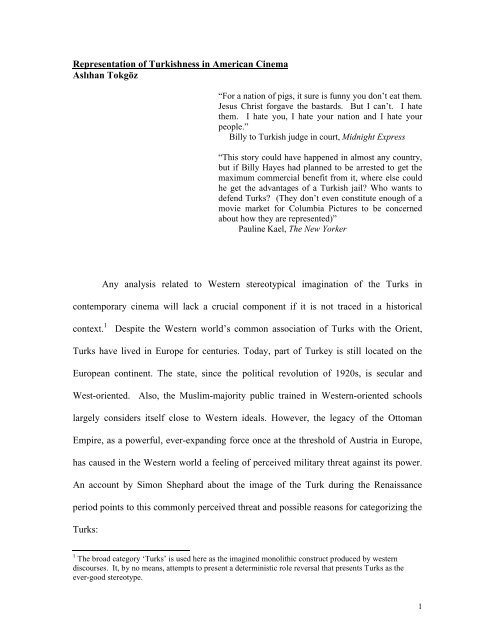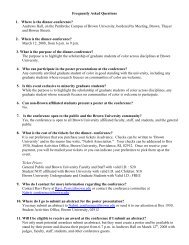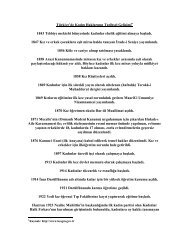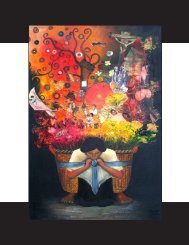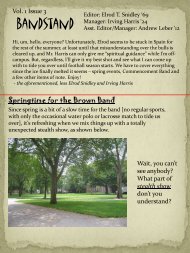Representation of Turkishness in American Cinema Aslıhan Tokgöz ...
Representation of Turkishness in American Cinema Aslıhan Tokgöz ...
Representation of Turkishness in American Cinema Aslıhan Tokgöz ...
Create successful ePaper yourself
Turn your PDF publications into a flip-book with our unique Google optimized e-Paper software.
“misrepresentation <strong>of</strong> Turks” <strong>in</strong> the West po<strong>in</strong>ts out that Turkey “is known only for itsmistakes and its brutalities”. She observes that “The Turks I saw <strong>in</strong> Lawrence <strong>of</strong> Arabiaand Midnight Express were like cartoon caricatures compared to the people I had knownand lived among for three <strong>of</strong> the happiest years <strong>of</strong> my life. 12Similarly, David Rob<strong>in</strong>sonstates that Midnight Express is “more violent, as a national hate-film than anyth<strong>in</strong>g (he)can remember” -a cultural form that “narrows horizons, confirm<strong>in</strong>g the audience’smeanest fears and prejudices and resentments”. 13Long after its release, even the film’s producer David Puttnam also accepted thatthe film is based on a “dishonest book”. 14For Puttnam, the story implies that Billy was<strong>in</strong>nocent; it focuses on much <strong>of</strong> his escape, though he was released under an amnestyagreement.Moreover, <strong>in</strong> 1986, director Alan Parker admitted that it was a mistake tocall Turkey “a nation <strong>of</strong> pigs” and that he “should have been smart enough, <strong>in</strong>tellectuallyand politically, to balance that remark”. 15Despite such assessments, the film was a great box <strong>of</strong>fice success and anextraord<strong>in</strong>ary achievement <strong>in</strong> the Golden Globe and Oscar awards. It received the Oscaraward for best screenplay and best music categories, while it was awarded the Goldenglobe Awards <strong>in</strong> all six categories available <strong>in</strong> 1979. Even more important, the film hasturned <strong>in</strong>to a significant referential po<strong>in</strong>t about the Turks <strong>in</strong> the memory <strong>of</strong> Westernaudiences. Thus, the Eurocentric gaze <strong>in</strong>herent to the film has led to a regenerativeprocess <strong>in</strong> which many other stereotypes <strong>of</strong> the Muslim Turkish subject could well beabsorbed <strong>in</strong> Western imag<strong>in</strong>ation with almost no resistance.12 Mary Lee Settle, Turkish Reflections (NY: Prentice Hall Press, 1991), pg 8.13 John Wakeman, (ed), World Film Directors, (New York: T.H. W. Wilson Co, 1988 ) vol II, pg 741.14 Shipman D, The Story Of C<strong>in</strong>ema, (London: Hadder and Stoughton, 1984), pg 1103.15 Andrew Horton, “Brita<strong>in</strong>’s Angry Young Man In Hollywood: An Interview With Alan Parker”,C<strong>in</strong>easte, New York, vol 15, no 12, (1986), pg 32.5
In its representation <strong>of</strong> Turks from the po<strong>in</strong>t <strong>of</strong> view <strong>of</strong> an <strong>American</strong>, Midnight Expressreproduces the ‘hegemonic’ gaze <strong>of</strong> the West so central to its relation with the Turksthroughout history. The po<strong>in</strong>t <strong>of</strong> view <strong>of</strong> the film is, <strong>in</strong>deed, that <strong>of</strong> Billy, the whitesubject, and this leads to the imposition <strong>of</strong> Turkish stereotypes both on an<strong>in</strong>dividual/character-identified and structural level.I call this the creation andregeneration <strong>of</strong> a Eurocentric gaze, <strong>in</strong> which both mental and perceptual subjectivity <strong>of</strong>the white are widely used at the expense <strong>of</strong> a loss <strong>of</strong> the subjectivity <strong>of</strong> the Other.Throughout the film, as noted Turkish critic and film maker Dervis Zayim observes,we are shown events from Billy's optical position or hear sounds as he hearsthem. For example, on his first night, before he is hung up by the ankles andclubbed by Hamidou, Billy Hayes hears trampl<strong>in</strong>g feet. Then we see him as heturns his head to learn who is com<strong>in</strong>g. Film is full <strong>of</strong> such perceptual subjectivity:He and the Swiss person are at the w<strong>in</strong>dow, watch<strong>in</strong>g while the Turks torture thechildren. We hear Muslim prayers as he hears and wakes up from his bed. Butthe perceptual subjectivity <strong>of</strong> Turks is quite restricted <strong>in</strong> the sense that we veryseldom hear or see th<strong>in</strong>gs from the Turk’s perceptual vantage po<strong>in</strong>t. Theexceptional cases to this are those <strong>in</strong> which they will attempt to harmsomebody. 16Billy’s subjectivity and the film’s obvious use <strong>of</strong> his po<strong>in</strong>t <strong>of</strong> view reflect theEurocentric structure <strong>of</strong> the film, that is, as Kaplan has stated <strong>in</strong> her discussion <strong>of</strong> theimperial gaze, one which fails to understand the local culture and one which embodiesanxiety due to loss <strong>of</strong> dom<strong>in</strong>ation. It is also important to note that the subjectivity <strong>of</strong> theTurks <strong>in</strong> the film is mere impossibility. They are rather objectified, dehumanized, evenhomosexualized for the white subject to deal with the anxieties <strong>of</strong> a possible castration.In this respect, Turks function <strong>in</strong> the filmic text as blacks do <strong>in</strong> <strong>American</strong> society; that isalthough they own a penis, they are seen by white men as a castration threat, and thus theanxiety leads the white man to not ‘see’ the Other even if he gazes at him. In Midnight16 Zaim, 18.6
Express, that takes the form <strong>of</strong> rigid stereotyp<strong>in</strong>g as either voiced by Billy or shownthrough po<strong>in</strong>t <strong>of</strong> view shots that exclude any human aspect <strong>of</strong> the Other from the filmicframe, or through fem<strong>in</strong>iz<strong>in</strong>g the Turks by focus<strong>in</strong>g on their homosexual tendencies, orby us<strong>in</strong>g surreal imagery at the most extreme level, such as <strong>in</strong> the scene <strong>in</strong> which Turkishpeople, the Muslim subjects, visually appear as pigs, thus totally animalized to the white,Christian subject.To sum up, Midnight Express is one Oscar-w<strong>in</strong>n<strong>in</strong>g movie that is just anotherexample <strong>of</strong> how the Western imag<strong>in</strong>ation constructs the Muslim Subject as ‘the primitiveother’. Hence, the filmic construction, through its representation <strong>of</strong> the relationshipbetween the Christian protagonist and the Muslim Turkish people, enhances andstabilizes previous conceptions <strong>of</strong> the non-Western subject. As such, the film re<strong>in</strong>forcesan 'imperial gaze', which re-creates this imag<strong>in</strong>ed relationship between the Western Selfand the Turkish Other.References:Broeske, Pat H. (1981). Magill’s <strong>American</strong> Film Guide. Vol. 3. NJ: Salem Press.Connolly, Roy (1982). Observer (London) Magaz<strong>in</strong>e. 30 May 1982.Kael, Paul<strong>in</strong>e (1980). When The Lights Go Down. New York: Hall R<strong>in</strong>ehart andW<strong>in</strong>ston.Said, Edward (1991). Orientalism. London: Pengu<strong>in</strong>.Shephard, Simon (1986). Marlowe and the Politics <strong>of</strong> Elizabethan Theatre. Sussex: TheHarvester Press.Shipman, David (1984). The Story <strong>of</strong> C<strong>in</strong>ema, Vol II. London: Hodder and Stoughton.Wakeman, John (Der.) (1988) World Film Directors, vol.II. New York: The H.W.Wilson Co.7
Zitto, Bobbi Leigh (Nisan 1980). Interview with Alan Parker. Focus on Film. Der.Allen Ayles. London: Tantivy Press.8


